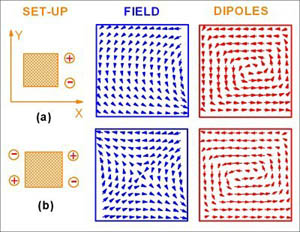US researchers have found a way to induce switching in nanoscale materials, a discovery that could lead the way to new types of memory devices for computer information storage, tiny sensors, and even nano motors to power microelectromechanical (MEMS) systems. The team comprises Sergey Prosandeev, Inna Ponomarena, Igor Kornev, Ivan Naumov, and Laurent Bellaiche of the University of Arkansas.
“The properties of nanoscale objects are often different from the properties of objects at the macroscopic scale,” Prosandeev explains, “We try to study the new properties of objects at the nanoscale to understand how to apply them to technology.” Prosandeev and his colleagues are investigating so-called ferroelectric compounds, materials that adopt electrical dipoles all lying along the same direction. Such materials are currently used in medical ultrasound, naval sonar and smart memory cards. Until now, scientists had assumed that the ferroelectric effect would fail if the crystals were close to the nanoscopic because of size effects.

Laurent Bellaiche
However, in a nanodot, a sub-microscopic sliver of ferroelectric crystal, this “loss” is governed by the swirling of charges within the nanodot, which cancel each other out. The Arkansas team decided to calculate the possibility of switching the direction of the charge vortex, which would open up the possibility of using these nanoscale materials in switches, sensors and other devices. The team used very complex but extremely close to nature computational techniques. “We use what are called methods from first-principles, which are known for their accuracy and microscopic insights,” Bellaiche told Spotlight.
First, the team investigated whether they could observe switching in their model using an inhomogeneous, or non-uniform, electric field formed by two different charges located at one side of the nanodot. They found that the external charges could be used to direct the vortex. When the charges were moved, the vortex moved, and when they swapped the two charges, the vortex swirled in the opposite direction.

Swirling fields make nanoswitches (Credit: Prossandeev et al)
The researchers explain that such vortex switching could be key to designing memory cards with phenomenal storage capacity far greater than currently possible. Such cards might be controlled by using a scanning tunnelling microscope (STM) tip close to nanodots laid out in array, and using the tip to generate the inhomogeneous electric fields.
Further reading
Phys Rev Lett, 2006, 96, 237601
http://dx.doi.org/10.1103/PhysRevLett.96.237601
Laurent Bellaiche
http://www.uark.edu/depts/physics/faculty/index.php?name=bellaiche
Computational Condensed Matter Physics Group, University of Arkansas
http://www.uark.edu/misc/aaron5/
Suggested searches
nanotechnology
elctric fields